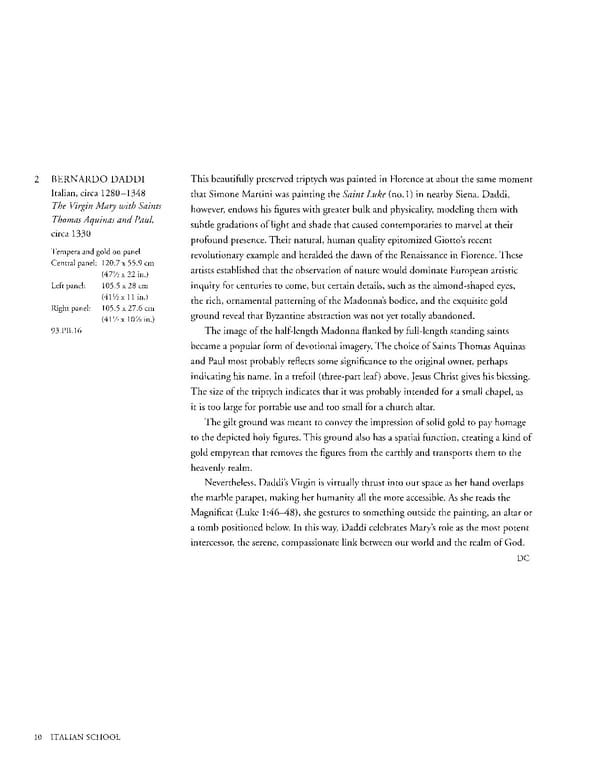2 BERNARDO DADDI This beautifully preserved triptych was painted in Florence at about the same moment Italian, circa 12801348 that Simone Martini was painting the Saint Luke (no. 1) in nearby Siena. Daddi, The Virgin Mary with Saints however, endows his figures with greater bulk and physicality, modeling them with Thomas Aquinas and Paul, subtle gradations of light and shade that caused contemporaries to marvel at their circa 1330 profound presence. Their natural, human quality epitomized Giotto's recent Tempera and gold on panel revolutionary example and heralded the dawn of the Renaissance in Florence. These Central panel: 120.7 x 55.9 cm (47½ x 22 in.) artists established that the observation of nature would dominate European artistic Left panel: 105.5 x 28 cm inquiry for centuries to come, but certain details, such as the almondshaped eyes, (41½ X 11 in.) the rich, ornamental patterning of the Madonna's bodice, and the exquisite gold Right panel: 105.5 x 27.6 cm (41½ x 10 7/8 in.) ground reveal that Byzantine abstraction was not yet totally abandoned. 93.PB.16 The image of the halflength Madonna flanked by fulllength standing saints became a popular form of devotional imagery. The choice of Saints Thomas Aquinas and Paul most probably reflects some significance to the original owner, perhaps indicating his name. In a trefoil (threepart leaf) above, Jesus Christ gives his blessing. The size of the triptych indicates that it was probably intended for a small chapel, as it is too large for portable use and too small for a church altar. The gilt ground was meant to convey the impression of solid gold to pay homage to the depicted holy figures. This ground also has a spatial function, creating a kind of gold empyrean that removes the figures from the earthly and transports them to the heavenly realm. Nevertheless, Daddi's Virgin is virtually thrust into our space as her hand overlaps the marble parapet, making her humanity all the more accessible. As she reads the Magnificat (Luke 1:46–48), she gestures to something outside the painting, an altar or a tomb positioned below. In this way, Daddi celebrates Mary's role as the most potent intercessor, the serene, compassionate link between our world and the realm of God. DC 10 ITALIAN SCHOOL
 Masterpieces of the Getty Museum: Paintings Page 10 Page 12
Masterpieces of the Getty Museum: Paintings Page 10 Page 12